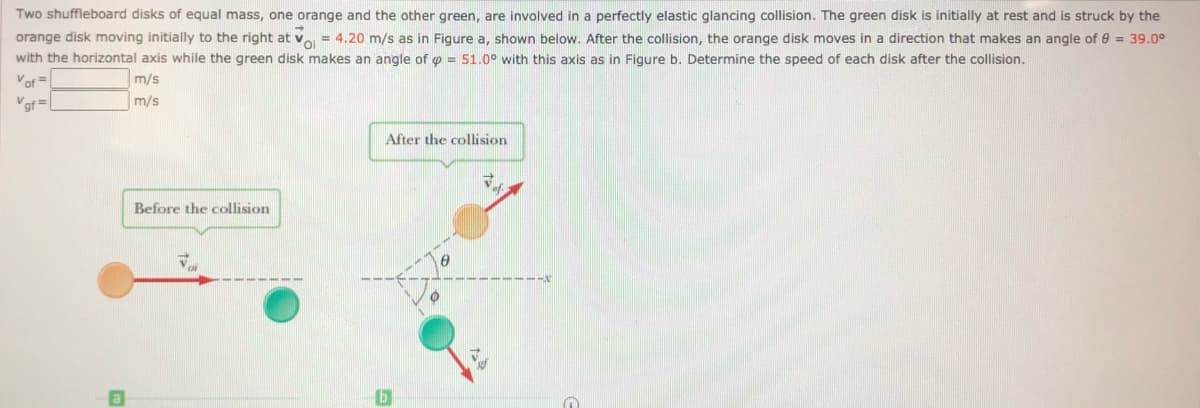Two shuffleboard disks of equal mass, one orange and the other green, are involved in a perfectly elastic glancing collision. The green disk is initially at rest and is struck by the orange disk moving initially to the right at vo with the horizontal axis while the green disk makes an angle of o = 51.0° with this axis as in Figure b. Determine the speed of each disk after the collision. = 4.20 m/s as in Figure a, shown below. After the collision, the orange disk moves in a direction that makes an angle of 0 = 39.0° Vor = m/s m/s After the collision Before the collision
Two shuffleboard disks of equal mass, one orange and the other green, are involved in a perfectly elastic glancing collision. The green disk is initially at rest and is struck by the orange disk moving initially to the right at vo with the horizontal axis while the green disk makes an angle of o = 51.0° with this axis as in Figure b. Determine the speed of each disk after the collision. = 4.20 m/s as in Figure a, shown below. After the collision, the orange disk moves in a direction that makes an angle of 0 = 39.0° Vor = m/s m/s After the collision Before the collision
Principles of Physics: A Calculus-Based Text
5th Edition
ISBN:9781133104261
Author:Raymond A. Serway, John W. Jewett
Publisher:Raymond A. Serway, John W. Jewett
Chapter8: Momentum And Collisions
Section: Chapter Questions
Problem 6OQ: A 2-kg object moving to the right with a speed of 4 m/s makes a head-on, elastic collision with a...
Related questions
Topic Video
Question

Transcribed Image Text:Two shuffleboard disks of equal mass, one orange and the other green, are involved in a perfectly elastic glancing collision. The green disk is initially at rest and is struck by the
orange disk moving initially to the right at vo = 4.20 m/s as in Figure a, shown below. After the collision, the orange disk moves in a direction that makes an angle of 9 = 39.0o
with the horizontal axis while the green disk makes an angle of o = 51.0° with this axis as in Figure b. Determine the speed of each disk after the collision.
Vof =
m/s
Vaf=
m/s
After the collision
Before the collision
Expert Solution
This question has been solved!
Explore an expertly crafted, step-by-step solution for a thorough understanding of key concepts.
This is a popular solution!
Trending now
This is a popular solution!
Step by step
Solved in 3 steps with 2 images

Knowledge Booster
Learn more about
Need a deep-dive on the concept behind this application? Look no further. Learn more about this topic, physics and related others by exploring similar questions and additional content below.Recommended textbooks for you

Principles of Physics: A Calculus-Based Text
Physics
ISBN:
9781133104261
Author:
Raymond A. Serway, John W. Jewett
Publisher:
Cengage Learning

College Physics
Physics
ISBN:
9781285737027
Author:
Raymond A. Serway, Chris Vuille
Publisher:
Cengage Learning

Glencoe Physics: Principles and Problems, Student…
Physics
ISBN:
9780078807213
Author:
Paul W. Zitzewitz
Publisher:
Glencoe/McGraw-Hill

Principles of Physics: A Calculus-Based Text
Physics
ISBN:
9781133104261
Author:
Raymond A. Serway, John W. Jewett
Publisher:
Cengage Learning

College Physics
Physics
ISBN:
9781285737027
Author:
Raymond A. Serway, Chris Vuille
Publisher:
Cengage Learning

Glencoe Physics: Principles and Problems, Student…
Physics
ISBN:
9780078807213
Author:
Paul W. Zitzewitz
Publisher:
Glencoe/McGraw-Hill

Physics for Scientists and Engineers with Modern …
Physics
ISBN:
9781337553292
Author:
Raymond A. Serway, John W. Jewett
Publisher:
Cengage Learning

Physics for Scientists and Engineers: Foundations…
Physics
ISBN:
9781133939146
Author:
Katz, Debora M.
Publisher:
Cengage Learning

University Physics Volume 1
Physics
ISBN:
9781938168277
Author:
William Moebs, Samuel J. Ling, Jeff Sanny
Publisher:
OpenStax - Rice University